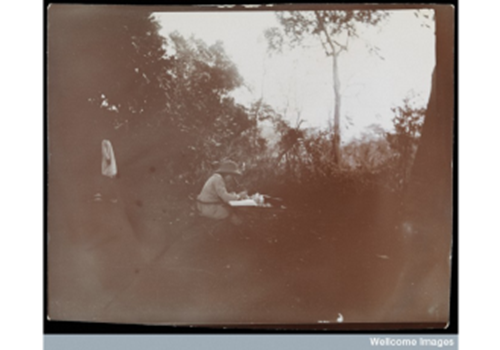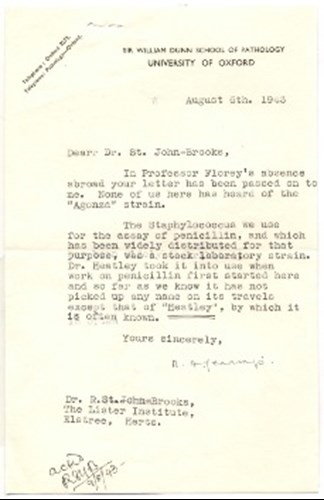NCTC and International Women's Day 2017

International Women's Day (IWD) exists as a vehicle for change and to promote gender equality. IWD 2017 asks us all to “Be Bold for Change” in pursuing a more gender inclusive world, helping to realise girls’ and womens’ ambitions, and call for gender balanced leadership by raising awareness and taking action now.
IWD also strives to highlight the social, economic, cultural and political achievement of women. Historically women have experienced greater barriers to the same opportunities afforded to men and hostility from the scientific establishment (among others), breeding a range of problems. For the first time in its history the majority of the National Collection of Type Cultures’ (NCTC) senior scientists and curators are women, and to celebrate IWD 2017 we look back into our history to pay tribute to the women who shaped and contributed to one of the world’s oldest working bacterial collections as it exists today.
Mabel Rhodes
Mabel Rhodes joined the Lister Institute, Chelsea (the original home of NCTC) as an artist, photographer’s assistant and illustrator in 1907 and in 1915 became the laboratory assistant of Dr Harriette Chick; the first female member of the Biochemical Society. At the formation of the NCTC in 1920 Rhodes became its first deputy curator. During her time there the collection grew and changed considerably; narrowing its focus to bacteria of medical importance, conducting the first freeze drying experiments on NCTC strains (a technique still used to preserve strains today), and having to move the entire collection from Chelsea to a farmhouse in Elstree at the onset of the Second World War.
In 1950 Rhodes published one of the first formal viability studies1 providing an early insight into the survival of freeze-dried bacterial strains. Viability studies such as this are one of the cornerstones of maintaining and curating the collection as it approaches its centennial. This, along with countless other contributions, ensured NCTC’s relevance, survival, and value to the scientific community during its early vital years.
Muriel Robertson
When NCTC was formed it somewhat relied on accessioning new strains from the private collections of the scientists working at the Lister Institute to increase the number and diversity of the bacterial strains it held. Reading through NCTC’s records, it is very clear that Muriel Robertson was one of these scientists. Almost 40 strains of Clostridium species deposited by her remain in the collection to this day, with almost all of them taken from cases of gas gangrene in soldiers who fought in the First World War. Kate Baker et al’s 2014 paper in The Lancet2 used another NCTC strain isolated during the First World War, NCTC 1, to study the evolution of the pathogen Shigella flexneri. It is not unreasonable to speculate that Robertson’s cultures may yield equally useful insights more than 100 years after their original isolation.
Robertson only studied the problem and bacteriology of gas gangrene during the two world wars. The majority of her work was as a protozoologist conducting pioneering work into the life cycle of the parasite Trypanosomagambiense; the cause of trypanosomiasis, or African sleeping sickness. This led her to travel to Ceylon and Uganda for field work. In 1947, she was among the first women to be elected as a Fellow of the Royal Society.
Rebecca C. Lancefield
Starting her work in bacteriology as a part-time technician in the lab of Oswald Avery and Alphonse Dochez while studying for her MA, Lancefield would end her career as one of the world’s most prolific streptococcal researchers. In 1917, Lancefield, Dochez and Avery investigated a high incidence of streptococcal pneumonia complicating measles cases in US army training camps in Texas3; NCTC 8302 being isolated at this time. This investigation identified that there were four immunologically distinct types in circulation, and that immunity to disease was likely to be type specific. Over the next six decades Lancefield continued to work exclusively on typing and classifying streptococcal types that cause disease, including her landmark 1933 paper4 which provided the basis of Lancefield group classification which in retrospect has been descried as “bringing order from chaos”.
Of all the methodologies used to try and classify streptococcal disease in the early 20th century, Lancefield groups endure as a major method of epidemiological investigation, and her discovery and elucidation of the M-protein component allowed the differentiation of Streptococcus pyogenes strains. Five strains isolated by Lancefield remain in NCTC, and with streptococcal disease on the rise in the UK in recent years5, Lancefield’s enduring contribution to the understanding of streptococcal biology and epidemiology seems as relevant as ever.
Betty C. Hobbs
Betty Hobbs set up the Food Hygiene Laboratory in Colindale, London in 1947 and established Clostridium perfringens as an important cause of food poisoning. Her first book Food Poisoning and Food Hygiene remains a landmark text on food microbiology. 20 strains of Clostridium perfringens were deposited by Hobbs, along with many other strains of food borne pathogens associated with gastro intestinal disease.
Naomi Datta
During an outbreak of Salmonella typhimurium at the Hammersmith hospital in 1959 and in pursuit of original research, Naomi Datta investigated whether the organism changed during the course of the outbreak. Upon analysis of 309 cultures and encouraged by then recent reports from Japan, Datta became one of the first researchers in Europe to identify transferable antibiotic resistance. With these findings Datta became more interested in what mediated the spread of antibiotic resistance, inevitably resulting much research into the biology of plasmids.
In 1980 Datta was instrumental in bringing the Murray Collection, a collection of pre-antibiotic era isolates of Enterobacteriaceae isolated between 1917 and 1954, from Canada to the UK. Upon establishing that a quarter of the strains within the collection were able to transfer DNA between bacteria, Datta and her research assistant Victoria Hughes published strong evidence that antibiotic resistance spreads through insertion of new genes into existing plasmids, rather than the proliferation of previously rare plasmids7. Datta and Hughes’ work was one of many important steps the strains in the Murray Collection took to reach where they are today; whole genome sequenced and available as a unique public health resource through NCTC8. After her work on the Murray collection, Datta lent her considerable expertise to NCTC by working briefly as a consultant, was elected a Fellow of the Royal Society and continued to pursue broad academic interests by studying both linguistics and human anthropology.
A letter from Maragret Jennings, Prof. H. Florey’s research assistant during the penicillin trials, regarding NCTC 6571. One of Jennings main roles in the development of penicillin was to assay it’s toxicity against white blood cells. Previous antibacterial agents were known to kill white blood cells and other immune cells of the human body in greater numbers than bacteria it was intended to treat.
(click the letter for a bigger image)
References
- Rhodes M. Viability of Dried Bacterial Cultures. Microbiology, September 1950 4: 450-456
- K. Baker et al. The extant World War 1 dysentery bacillus NCTC1: a genomic analysis. Lancet. 2014 Nov; 384(9955): 1691–1697.
- Dochez AR, Avery OT and Rebecca Lancefield. Studies on the biology of streptococcus. I. Antigenic relationship between strains of Streptococcus haemolyticus. J Exp Med, 1919, 30: 179
- RC Lancefield A SEROLOGICAL DIFFERENTIATION OF HUMAN AND OTHER GROUPS OF HEMOLYTIC STREPTOCOCCI J Exp Med. 1933 Mar 31; 57(4): 571–595
- R Guy et al. Increase in scarlet fever notifications in the United Kingdom, 2013/2014. Euro Surveill. 2014 Mar 27;19(12):20749
- Datta, Naomi Transmissible drug resistance in an epidemic strain of Salmonella typhimurium Journal of Hygiene. 60 (3): 301–310
- Datta N, Hughes VM. Plasmids of the same Inc groups in Enterobacteria before and after the medical use of antibiotics Nature. 1983 Dec 8-14;306(5943):616-7
- K S Baker et al. The Murray collection of pre-antibiotic era Enterobacteriacae: a unique research resource. Genome Med. 2015 Sep 28;7:97

